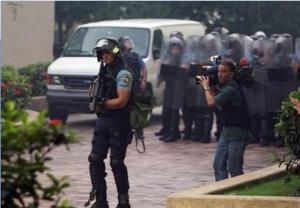Literature as a Future
By: Stephanie Figueroa
“Television is infecting the mind much faster than bacteria” (Foster, 2001) Because of such infection, students who become fascinated with literature are less.
Due to that number being less, the amount of students who enroll at the University for English Literature are also less.
In August 2010, 18 students matriculated into the English department at the University of Puerto Rico at Mayagüez. Six of which have already talked about transferring to another department, according to Gloria Muniz.
Since I have knowledge of who the remaining 12 are, I set up an interview to see what they wanted to do with an English bachelor’s degree. Seven have already said they wanted to major in Linguistics. Two clearly stated that they did not know what they wanted to do with English. And the single one said “Literature…of course”, and the remaining two were unavailable for questions.
Literature has much to offer students especially if it’s at UPRM.
The UPRM English Department has the club EDSA to back them up. EDSA is a group of students, no matter which department that gather together to create festivals.
The most wide received one is the Literature Festival. Each year, students write something that has to do with that year’s theme and perform it on stage.
This year, the festival was about Children’s Literature. Students re-wrote fairytales and twisted them a bit to make them more entertaining for older students.
Presentations were also given about the importance of literature at a young age.
Angel Matos, a Master’s Students a UPRM spoke about his adventure into literature and the impact it had made in his life.
“With Literature you can enter a world of endless imagination, where only you are the creator” said Angel Matos during his presentation.
Much of what we see today on television is based on stories and poems written centuries ago. Yet what we see on television is just an imitation. Wouldn’t you like to know what the real story said?
With Literature, you get to go back in time and read about Shakespeare tragedy and loss, Oscar Wilde’s soul swapping portrait, Beowulf, a man with the strength of 30 men in one hand, and poetry, not about heartbreak, but about the most important thing in the world, nature and everything it’s tied to.
But Literature is not all about reading. The UPRM offers many courses where you can learn how to write like the famous authors of the past and the ones like to day. Isn’t that cool?
In the course Expository Writing, you get to write about events that created an impact in your life, you get to play the field and interview people about a topic that interests you, and you even get to write a debatical essay on what you think is most important.
There is also a Creative Writing course, where you get to write whatever you like. You get to use your own imagination, and write about things that are out of this world. Unlike math and Science, where everything must be proven.
The professors at the UPRM English Department are not pieces of cake. Dr. Nandita Batra, Dr. Nick Haydock, Prof. Jose Irizarry, Prof. Mary Leonard, and Prof. Gayle Griggs (to name a few) are somewhat of a challenge.
They all motivate their students to read and be ready for in class discussion. But despite reading something that was written centuries ago, and is boring, like normal high school books are, you will begin to enjoy the assigned readings and learn more from them each time.
But reading doesn’t always have to be written by dead people. Many professors also motivate you to read something for class written not too long ago. Such as Lois Lowry.
Even if you do study Literature, what kind of future can you have?
Haven’t you ever wanted to be famous for something? When I was a little girl I always thought I’d be famous for being the first female president. But now that I’m older, I want to be famous because I’ll be a great writer.
But being a story writer is not the only thing you can do with a literature bachelor’s degree.
You can teach, be an actor, journalist, publisher, proofreader, Media Representative, a communications specialist, or an editor, (to name a few).
The English program the UPRM has to offer is not big enough like other schools, but in my opinion, it is definitely the best, since everyone there challenges you to become a better reader and writer.
















